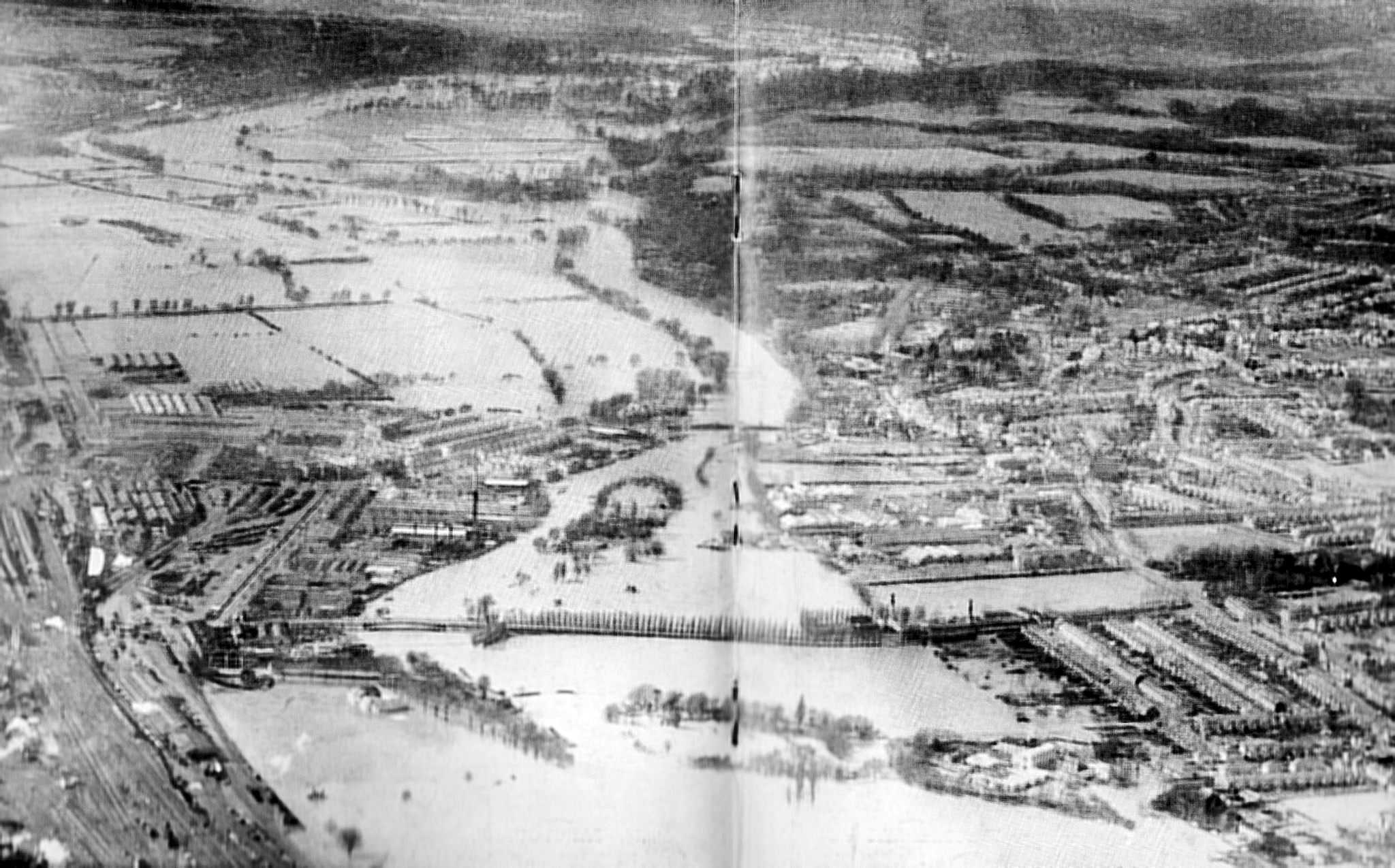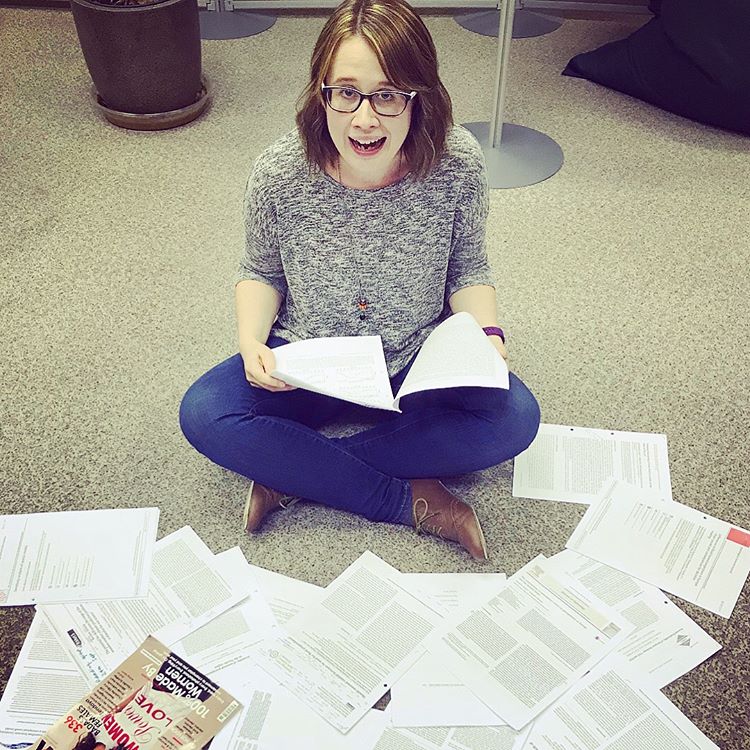The Environment Agency is consulting on a new flood alleviation scheme for Reading, to be sited on the banks of the River Thames in Caversham, and they’re inviting local residents to look at the proposals online and give feedback. Reading environmental scientist and Caversham resident Dr Liz Stephens gives her thoughts on the scheme.

There are plenty of photographs of the 1947 flood in Reading, including this one taken from a plane. Credit: The County Borough of Reading, via Bob Jones
Caversham may have been fortunate to miss out on the worst of the flooding along the Thames in recent memory, but the scale of the flooding experienced in 1947 shows that many people in lower Caversham may unknowingly live in areas at high risk of flooding.
The extraordinary level of the 1947 flood is marked on a pole by Reading Bridge/Whittington’s Tea Barge, which is visible from the Thames Path. It wasn’t a one-off either, as photographs in Reading Museum point to significant flooding in 1894.
Continue reading →
Talk by Fred L. Ogden, Ph.D. Professor, UCAR Senior Visiting Scientist and Academic-in-Residence, NOAA/NWS Office of Water Prediction, National Water Center, Tuscaloosa, Alabama, USA
ABSTRACT
When rain falls, some or all of it enters into or “infiltrates” the soil. The rain that does not infiltrate becomes surface water that can cause flooding, so it is of great interest to people making flood predictions. Predicting how much rainfall infiltrates is a problem that has historically presented hydrologists with much difficulty. Despite the fact that the so-called Richards’ equation was first posited by Richardson in 1922, identification of a general, accurate, and reliable solution has evaded hydrologists for generations- until now.

Because of the many computational difficulties associated with reliable and accurate solution of Richards’ equation, hydrologists have developed approximate solutions of various complexity, none of which approach the capabilities of the Richards’ solution except in the simplest of cases. Developed together with then Ph.D. student Cary Talbot, the finite moisture-content solution methodology was published in 2008, as another approximation lacking deep theoretical justification. However, in 2014 after some new theoretical work with his research group, Prof. Ogden set up a laboratory column experiment to collect data to validate a revised finite moisture-content solution to simulate groundwater table dynamic effects on the water content of the unsaturated zone. The new solution methodology performed as well or by some measures, better than numerical solution of Richards’ equation, and led to identification of the Soil Moisture Velocity Equation (SMVE), a completely new formulation that is equivalent to Richards’ equation but with velocity as the dependent variable. The SMVE consists of two parts. The first “advection-like” part accounts for the flow associated with gravity and the integrated (scalar) capillarity of the wetting front, and can be solved as an ordinary differential equation using the finite moisture-content discretization. The second “diffusion-like” part accounts for flows due to the shape of the wetting front, and is negligibly small in all cases tested thus far. The finite moisture-content solution of the advection-like term is a fast general, accurate, and reliable vadose zone flow calculation method, representing a technological first.
Water@Reading PhD student Rebecca Emerton is often asked how she got a paper published in Nature at such an early stage in her career. She shares her top five tips for getting published in a major journal and tells us about the research that caught the editor’s eye.

Continue reading →
By Professor Hannah Cloke, hydrologist, Water@Reading
If you knew there was a strong chance that your local river was about to burst its banks and sweep away your house, you’d get yourself, and your family, out of harm’s way.
Yet tragically, despite major advances in flood forecasting, hundreds of people every year still die in floods. Either warnings are not getting through, or people and authorities are failing to take appropriate action.

Severe flooding brought on by a strong coastal El Nino has left more than 90 dead and hundreds of thousands homeless in Northern Peru [photo: Maria-Helena Ramos]
This month has again seen severe flooding in many parts of the world, including Peru and Australia, leading to loss of life and destruction of homes and livelihoods.
We will never be able to stop such awful floods. But there are some vital steps that we can take to reduce the risk from these events and to save lives.
In recent years we have been taking great strides in our capability to provide early flood warnings, so that people can prepare for upcoming floods – often before it even starts to rain.
The Water@Reading research group at the University of Reading works alongside flood forecasters to develop better forecasts and warnings, such as those of the European Flood Awareness System (EFAS) and the Global Flood Awareness System (GloFAS), part of the EU’s Copernicus Emergency Management Service.
But how do we know if we’re doing a good job? How can we convince people that the warnings are accurate, and worth acting on?
Continue reading →
By Rebecca Emerton, Water@Reading research group
When an El Niño is declared, or even forecast, we think back to memorable past El Niños (such as 1997/98), and begin to ask whether we will see the same impacts. Will California receive a lot of rainfall? Will we see droughts in tropical Asia and Australia? Will Peru experience the same devastating floods as in 1997/98, and 1982/83?
El Niño and La Niña, which see changes in the ocean temperatures in the tropical Pacific, are well known to affect weather, and indeed river flow and flooding, around the globe. But how well can we estimate the potential impacts of El Niño and La Niña, and how likely flooding is to occur?
This question is what some of us in the Water@Reading research group at the University of Reading have been looking to answer in our recent publication in Nature Communications.
Continue reading →
By Phil Newton, Research Dean for the Environment Theme, University of Reading
‘Impact sometimes needs to be nurtured over long timescales… there is more to impact than developing case-studies for the next REF exercise’
The University of Reading is known across the world for the quality of its research in the environmental sciences. As Research Dean for the Environment Theme, I’m lucky enough to have the best seat in the house to see, up close, not just that quality, but also what a huge impact some of that research has on people’s lives.
 So it’s gratifying when others celebrate the influence of Reading’s research, as the Natural Environment Research Council (NERC) has done this week with the publication of its new annual report about the impact of NERC-funded research.
So it’s gratifying when others celebrate the influence of Reading’s research, as the Natural Environment Research Council (NERC) has done this week with the publication of its new annual report about the impact of NERC-funded research.
The NERC Impact Report 2016 shows how sustained NERC investment in environmental researchers working in partnership with the likes of governments, businesses and charities generates large, long-term economic and societal benefits – contributing to building a safer, healthier and more secure and sustainable world. It is great to see highlighted two areas of Reading research that are having substantial impact.
Reducing the tragedy of flooding
One is about the work of hydrologist Professor Hannah Cloke, and how the modelling and engagement work by Hannah and her colleagues over many years has improved the quality of flood forecasting, and changed the policy and practice of flood prevention, in the UK. These changes have been a major contribution to dramatic reductions in household flooding incidence over the past decade.
Continue reading →






